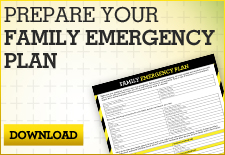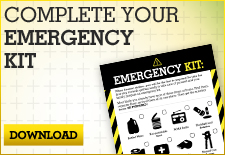
Disasters can happen… at any time. Be prepared to take action before, during and after.
Terrorism is the unlawful use of force or violence by a person or group. The goal is to intimidate or coerce societies or governments in an effort to promote political or ideological beliefs. These attacks can take many forms, and could happen at any time in any place. Terrorists typically exploit vulnerabilities, and may use technology, hazardous materials, biological agents or other methods to create devastating disruptions to the community. Terrorism thrives on fear. By planning how to respond to a terrorist attack, you can greatly improve your chances of survival. You can also lessen the impact of the attack by reducing the fear in the aftermath.
For more information visit: If You See Something, Say Something
In case of a terrorist attack, you can find detailed information from local public safety agencies, and your local TV and Radio stations. Also, contact your local police department or local emergency management agency for preparedness information or visit the Department of Homeland Security by visiting: www.dhs.gov.
Before
Some actions can be taken prior to a terrorist incident to prepare you and your family. This may include informing yourself about the risks that might impact your community and planning for how you may respond.
2 – Complete the Emergency Contacts Card and place one in your Emergency Kit.
3 – Prepare an Emergency Kit. The Emergency Kit should be easily accessible should you and your family be forced to shelter in place (stay at home) for a period of time.
- When is the bomb going to explode?
- Where is it right now?
- What does it look like?
- What kind of bomb is it?
- What will cause it to explode?
- Did you place the bomb?
Try to keep the caller on the line and record everything that is said. Notify the police and building management immediately. If the threat seems credible, evacuate the building immediately.
- Unexpected or unfamiliar senders.
- No return address or a return address that can’t be verified as legitimate.
- Marked with restrictive endorsements such as “Personal,” “Confidential,” or “Do not X‐ray.”
- Have protruding wires or aluminum foil, strange odors or stains.
- Show a city or state in the postmark that doesn’t match the return address.
- Are of unusual weight given their size or are lopsided or oddly shaped.
- Are marked with threatening language.
- Have inappropriate or unusual labeling.
- Have excessive postage or packaging material, such as masking tape and string.
- Have misspellings of common words.
- Are addressed to someone no longer with your organization or are otherwise outdated.
- Have incorrect titles or titles without a name.
- Are not addressed to a specific person.
- Have hand‐written or poorly typed addresses.
If a terrorist attack occurs, it is important that you remain calm and follow instructions from local officials and emergency service personnel. You should be aware of your surroundings and watch for additional attacks. Listen to local TV and radio for directions and travel information and instructions from local officials. If you are in a position where the attack occurs near you, check for injuries and provide first‐aid.
- If the disaster occurs near your home while you are there, check for damage using a flashlight. Do not light matches or candles or turn on electrical switches. Check for fires, fire hazards and other household hazards. Sniff for gas leaks, starting at the water heater. If you smell gas or suspect a leak, turn off the main gas valve, open windows, and get everyone outside quickly.
- Shut off any other damaged utilities.
- Confine or secure your pets.
- Call your family contact—do not use the telephone again unless it is a life‐threatening emergency. In some cases, cell phones will not work. Consider texting or other ways of communicating.
- Check on your neighbors, especially those who are elderly or disabled.
- Call 9‐1‐1
- Get under a sturdy table or desk if things are falling around you. When they stop falling, leave quickly, watching for obviously weakened floors and stairways. As you exit from the building, be especially watchful of falling debris.
- Leave the building as quickly as possible. Crawl low to the floor if there is smoke. Do not stop to retrieve personal possessions or make phone calls.
- Do not use elevators.
- Check for fire and other hazards.
- Once you are out, do not stand in front of windows, glass doors or other potentially hazardous areas.
- Move away from sidewalks or streets to be used by emergency officials or others still exiting the
building. - If you are trapped in debris: o Use a flashlight, if possible, to signal your location to rescuers.
– Tap on a pipe or wall so rescuers can hear where you are.
– If possible, use a whistle to signal rescuers.
– Shout only as a last resort. Shouting can cause you to inhale dangerous amounts of dust.
– Avoid unnecessary movement so you don’t kick up dust. - Cover your nose and mouth with anything you have on hand. (Dense‐weave cotton material can act as a good filter. Try to breathe through the material.)
After a terrorist attack, expect heavy law enforcement involvement at the local, state and federal levels. These agencies will investigate the incident and the location will be treated as a crime scene. Your workplace or school may be closed, and there may be restrictions on domestic and international travel. You and your family may have to evacuate the area, as instructed by local law enforcement officials. Further, expect extensive media coverage and increased law enforcement presence, even if the attack did not occur in your community.



